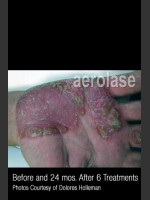Summer Basics for Melasma

Jordan V. Wang, MD, MBE
Melasma is a common skin condition that causes dark patches to appear, typically on the face. Although these patches cause no direct symptoms, people may feel distressed from their appearance alone. Knowing how to manage this condition, especially during summer months, can help people learn to better live with it.
Melasma is much more common in women. Only about 10% of those who are affected by it are men. It is also more common in ethnicities with darker skin tones, such as Latino and Hispanic, Asian, Indian, and the Mediterranean. Those who have family members with melasma may also be more prone to develop it.
Melasma is thought to be due to increased melanin production in skin cells, which is a pigment produced by melanocytes that darken the skin's color. However, the exact cause of this increased production is not yet well-understood. Ethnicities with darker skin tones have more active melanocytes, which leads to their predisposition. A change in the body?s hormones, such as during pregnancy or from birth control pills, can also be attributed as a cause of melasma. Some cosmetics and skincare products have been thought to be culprits as well.
Sun exposure plays a significant role in influencing melasma. Ultraviolet (UV) rays from the sun stimulate the skin's melanocytes to further increase their production of melanin. This, in turn, can trigger more patches to appear or even re-appear after they had previously faded. Increased sun exposure is the main reason why the majority of people are most affected in the summer months.
Two of the best management strategies are to practice good sun avoidance and wear daily sunscreen. Using a sunscreen with high SPF and UVA/UVB protection can help to prevent worsening of melasma. Sunscreen products containing the particular ingredient iron oxide were also shown to be helpful. Reapplication of sunscreen every couple of hours throughout the day can be beneficial. No matter which treatments--if any at all--are ultimately used, these two strategies are crucial.
Occasionally, melasma can fade or improve on its own, especially if caused by a change in your body's hormones once that trigger is no longer present. Often times though, melasma becomes a chronic condition that people will need to learn to manage year after year. Various treatment options and procedures fortunately exist for improving appearance. However, they may require a few months to notice any significant results. The use of topical medications can help to lighten these dark patches of skin, and include hydroquinone, tretinoin, and corticosteroids--or a combination of these. Over-the-counter topical products, such as arbutin, can help with maintenance after treatment of the acute phase. Procedures, such as chemical peels and laser treatments, have also been shown to be effective at managing melasma if done on a consistent basis. Due to the potential of any treatments possibly worsening melasma and causing further discoloration, consultation by a certified dermatologist is highly recommended.
Although melasma can be stubborn, you shouldn't let it ruin your summer.


